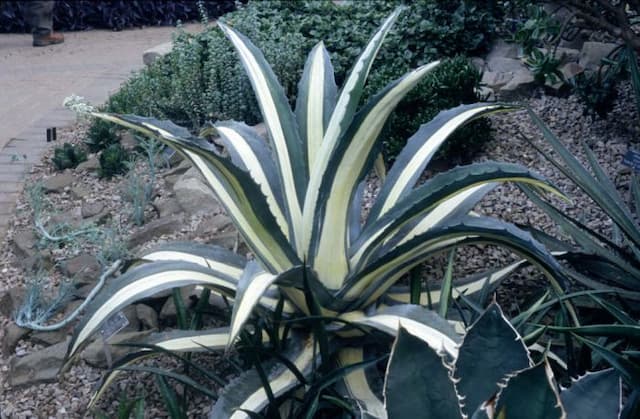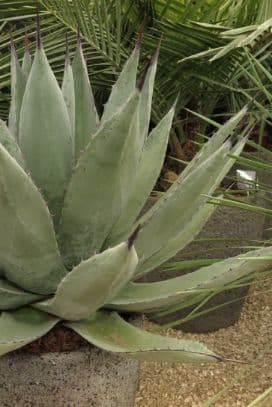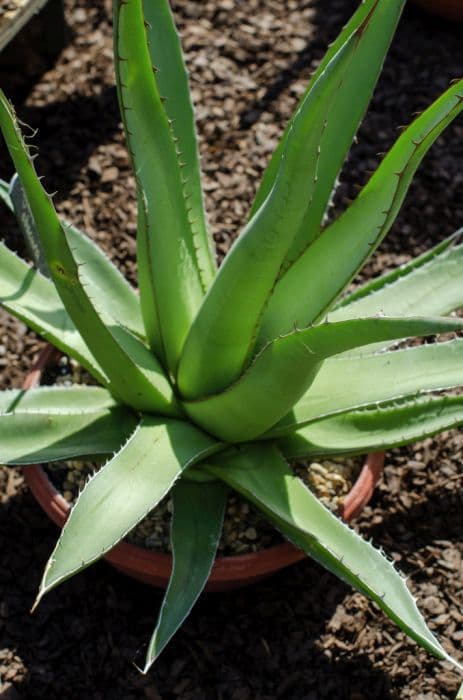Red Star Spike Cordyline 'Torbay Red'

ABOUT
Cordyline 'Torbay Red', commonly known as Red Dracaena, is an exotic-looking plant characterized by its striking foliage. The leaves are arching and sword-like, exuding a vibrant reddish-pink color at the center and transitioning to a bronze-green towards the edges. This colorful display contributes to a bold, architectural statement in any setting where the plant is used. The leaves emanate from a central point, creating a fountain-like effect that adds dynamic movement and texture to the plant's overall appearance. The Red Dracaena has a palm-like quality, lending an air of the tropics to wherever it is situated. Its lush, evergreen foliage is retained throughout the year, which makes it a popular choice as a focal point in gardens or as part of mixed borders where its intense color can create striking contrasts with other plants.
About this plant
 Names
NamesFamily
Asparagaceae
Synonyms
Red Cordyline, Red Dracaena, Red Star Cordyline, Torbay Palm
Common names
Cordyline australis 'Torbay Red', Dracaena australis 'Torbay Red'.
 Toxicity
ToxicityTo humans
The Red Star Spike, commonly referred to as Cordyline 'Torbay Red', is not known to be toxic to humans. However, sensitive individuals may experience mild irritation upon contact with the sap. Ingesting parts of the plant is generally not advised, but it is not expected to cause severe poisoning. If large quantities were consumed, one might experience gastrointestinal discomfort or other mild reactions.
To pets
The Red Star Spike, commonly known as Cordyline 'Torbay Red', is considered to have mild to moderate toxicity to pets such as cats and dogs. If a pet ingests parts of this plant, symptoms of poisoning may include vomiting, diarrhea, drooling, weakness, or, less commonly, dilated pupils. It's recommended to seek veterinary advice if your pet shows any sign of distress after consuming any part of the plant.
 Characteristics
CharacteristicsLife cycle
Perennials
Foliage type
Evergreen
Color of leaves
Red
Height
8-10 feet (2.4-3 meters)
Spread
2-3 feet (0.6-0.9 meters)
Plant type
Shrub
Hardiness zones
9
Native area
New Zealand
Benefits
 General Benefits
General Benefits- Aesthetic Appeal: Adds a vibrant red accent and a tropical look to gardens and landscapes.
- Low Maintenance: Requires minimal care once established, making it a good choice for busy gardeners.
- Drought Tolerance: Can withstand periods of low water, suitable for water-efficient gardening.
- Frost Resistance: More robust against cooler temperatures than other tropical plants.
- Versatility: Can be grown in containers, pots or directly in the ground, offering flexible gardening options.
- Evergreen Foliage: Maintains its color and leaves throughout the year, ensuring constant garden interest.
- Architectural Form: Provides strong vertical lines and structure within a garden design.
- Attracts Wildlife: Can be a source of food and shelter for certain bird species.
- Long Lifespan: With proper care, it can be a long-term feature in the garden.
- Soil Adaptability: Adapts to a range of soil types, from sandy to loamy.
 Medical Properties
Medical PropertiesThis plant is not used for medical purposes.
 Air-purifying Qualities
Air-purifying QualitiesThis plant is not specifically known for air purifying qualities.
 Other Uses
Other Uses- Crafting Material: The long, sword-like leaves of the Cordyline can be dried and woven into decorative items such as wall hangings or even used in thatching for small garden structures.
- Eco-Friendly Fabric Dye: The red hues of 'Torbay Red' leaves may be used to create a natural dye for fabrics, giving them an eco-friendly tinge of color.
- Theme Gardens: This plant is perfect for adding an exotic, tropical feel to themed gardens, such as a New Zealand-theme or a seaside garden design.
- Culinary Garnish: Although not commonly consumed, the vibrant leaves can be used as a tropical garnish for plating and presenting dishes in high-end culinary settings.
- Privacy Screening: When planted in groups, 'Torbay Red' can form a dense and colorful screen, offering privacy in gardens and urban spaces.
- Photography Prop: Due to its striking coloration, it can be used as a visually appealing prop or backdrop in photography, particularly in fashion and plant photography.
- Holiday Decor: The red leaves can be incorporated into festive wreaths or decorations around Christmas for a more natural and unique decor.
- Floral Arrangements: Stems of the Torbay Red can add height and a pop of color to both fresh and dried floral arrangements.
- Edging Plant: Its upright form and distinctive foliage make it an ideal plant for edging paths or borders in landscaping designs.
- Fantasy Costuming: The dramatic leaves and styling of the Cordyline can be used in the creation of costumes, especially for fantasy or science fiction characters.
Interesting Facts
 Feng Shui
Feng ShuiThe Red Star Dracaena is not used in Feng Shui practice.
 Zodiac Sign Compitability
Zodiac Sign CompitabilityThe Red Star Dracaena is not used in astrology practice.
 Plant Symbolism
Plant Symbolism- Longevity - Cordylines are known for their long life and can be a symbol of enduring life and vitality.
- Mysticism - The 'Torbay Red' variety, with its vibrant red leaves, can be associated with mystery and enchantment, often used in mystical or spiritual practices.
- Protection - In some cultures, cordylines are planted around homes as they are believed to ward off evil spirits and provide protection.
- Healing - Traditionally, some Cordyline species have been used for their medicinal properties, making them a symbol of healing and health.
- Good Luck - The lush appearance and hearty nature of the plant often make it a symbol of good luck and prosperity.
 Water
WaterThe Red Star Cordyline requires watering once the top inch of soil has dried out, which typically means about once every week or two, depending on environmental conditions. During the active growth season, in the spring and summer, water the plant thoroughly, using approximately 1-2 gallons for a medium-sized outdoor plant or a few ounces for smaller indoor pots, ensuring the water reaches deep into the root zone. In the winter, reduce watering frequency to every 2-3 weeks due to slower growth and cooler temperatures, making sure not to let the soil become completely bone dry. Avoid overwatering, as this can lead to root rot, a common problem with this species if left in soggy soil for too long.
 Light
LightRed Star Cordyline thrives best in bright, indirect sunlight and can also tolerate direct sunlight for a few hours, especially in the morning. An ideal spot for this plant is near an east or west-facing window where it can get a mix of sun and shade throughout the day. However, too much direct afternoon sun can scorch the leaves, so in very sunny environments, some light shading may be necessary.
 Temperature
TemperatureRed Star Cordyline prefers a temperature range between 65 and 80 degrees Fahrenheit for optimal growth. It can tolerate temperatures down to about 50 degrees Fahrenheit but cannot survive freezing temperatures. To prevent cold damage, keep indoor plants away from drafts and outdoor plants should be brought in or protected when the temperature is expected to drop below 50 degrees Fahrenheit.
 Pruning
PruningRed Star Cordyline benefits from pruning to remove dead or damaged leaves and to encourage bushier growth. Pruning is best done in the spring before the growing season starts. Cut back any yellowing or brown leaves at the base, and cut off flower spikes after blooming to conserve the plant's energy. Pruning once a year or as needed when the foliage appears unkempt is usually sufficient.
 Cleaning
CleaningAs needed
 Soil
SoilThe ideal soil mix for a Cordyline, or New Zealand Cabbage Palm, should be well-draining and rich in organic matter. A mixture of two parts peat moss, one part perlite, and one part potting soil is recommended. The soil pH should be slightly acidic to neutral, around 6.0 to 6.5.
 Repotting
RepottingNew Zealand Cabbage Palms should be repotted every 2-3 years to refresh the soil and accommodate root growth. Young plants may require more frequent repotting, while mature ones can be repotted less often.
 Humidity & Misting
Humidity & MistingNew Zealand Cabbage Palms prefer moderate to high humidity levels, ideally around 40-50%. They can withstand some degree of dry air but thrive in more humid conditions.
 Suitable locations
Suitable locationsIndoor
Place in bright, indirect light; water when top soil feels dry.
Outdoor
Shelter from strong winds; full sun to partial shade; well-draining soil.
Hardiness zone
8-11 USDA
 Life cycle
Life cycleCordyline 'Torbay Red', more commonly known as the Red Star Spike, begins its life cycle as a seed or can be propagated through stem cuttings. Upon germination or rooting, the young plant enters a growth phase where it develops long, sword-like burgundy leaves and a woody stem, thriving in well-drained soil and full sun to partial shade. As the Red Star Spike matures, it forms a trunk-like structure and can reach up to 10-15 feet tall. The adult plant may produce small, fragrant white to pale pink flowers in the summer on panicles up to 3 feet long, which are attractive to bees and butterflies. After flowering, berry-like fruits can form, containing seeds that may disperse to start a new generation. The Red Star Spike can live for several years, with older plants sometimes experiencing die-back in colder climates but can resprout from the base if the roots are protected from frost.
 Propogation
PropogationPropogation time
Spring-Early Summer
Cordyline 'Torbay Red', commonly known as Red Star Spike, can be propagated most effectively through stem cuttings. This process is best done in late spring or early summer when the plant's growth is most active. To propagate, a grower would take a healthy stem cutting, usually about 3 to 5 inches (approximately 7.5 to 12.7 cm) long, ensuring there are several leaf nodes on the cutting. The bottom leaves are removed, and the cutting is inserted into a pot filled with a well-drained potting mix. It's then important to keep the soil moist and provide the cutting with appropriate warmth and indirect light until new growth indicates that rooting has occurred. This simple yet effective method helps in expanding your collection of this strikingly colorful plant without the need for specialized equipment or skills.









